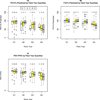Influence of C-159T SNP of the CD14 gene promoter on lung function in smokers
- PMID: 19361972
- PMCID: PMC3178042
- DOI: 10.1016/j.rmed.2009.03.007
Influence of C-159T SNP of the CD14 gene promoter on lung function in smokers
Abstract
CD14, a co-receptor for endotoxin, plays a significant role in regulating the inflammatory response to this agent. The C-159T single nucleotide polymorphism (SNP) in the CD14 gene promoter is an important regulator of CD14 expression, with TT homozygotes having increased expression of CD14. This SNP has been linked to pathogenesis of asthma and with cardiovascular diseases in smokers. We hypothesize that CD14 also plays a role in the pathophysiology of COPD in smokers who are exposed to endotoxin contained in cigarette smoke as well as endotoxin derived from Gram-negative microbes colonizing their airways. To assess the effect of the C-159T SNP of the CD14 gene promoter on lung function, we recruited 246 smokers 40 years of age or older with a range of 10-156 pack-year smoking exposures. The TT genotype was associated with lower lung function in smokers with a moderate smoking history. However, the CC genotype was associated with decreased lung function in heavy smokers (>56 pack years). The effect of CC genotype on severity of COPD is analogous with the effect of this genotype in risk for asthma. CD14 may be a factor in the pathophysiology of COPD, as it is in asthma and smoking-related cardiovascular diseases.
Conflict of interest statement
Conflict of Interest Statement
None of the authors have a conflict of interest to declare in relation to this work.
Figures


Similar articles
-
Interaction of CD14 haplotypes and soluble CD14 on pulmonary function in agricultural workers.Respir Res. 2017 Mar 16;18(1):49. doi: 10.1186/s12931-017-0532-y. Respir Res. 2017. PMID: 28302109 Free PMC article.
-
Lack of effect of the CD14 promoter gene C-159T polymorphism on nutritional status parameters in hemodialysis patients.Med Sci Monit. 2011 Feb;17(2):CR117-21. doi: 10.12659/msm.881397. Med Sci Monit. 2011. PMID: 21278688 Free PMC article.
-
Association of serum CD14 level and functional polymorphism C-159T in the promoter region of CD14 gene with allergic rhinitis.Clin Exp Med. 2023 Dec;23(8):4861-4869. doi: 10.1007/s10238-023-01097-y. Epub 2023 Jun 7. Clin Exp Med. 2023. PMID: 37286630 Free PMC article.
-
CD14 C-159T and toll-like receptor 4 Asp299Gly polymorphisms in surviving meningococcal disease patients.PLoS One. 2009 Oct 7;4(10):e7374. doi: 10.1371/journal.pone.0007374. PLoS One. 2009. PMID: 19809507 Free PMC article.
-
The C-159T polymorphism in the CD14 promoter is associated with serum total IgE concentration in atopic Chinese children.Pediatr Allergy Immunol. 2003 Aug;14(4):255-60. doi: 10.1034/j.1399-3038.2003.00048.x. Pediatr Allergy Immunol. 2003. PMID: 12911501
Cited by
-
Interaction of CD14 haplotypes and soluble CD14 on pulmonary function in agricultural workers.Respir Res. 2017 Mar 16;18(1):49. doi: 10.1186/s12931-017-0532-y. Respir Res. 2017. PMID: 28302109 Free PMC article.
-
Updates on the COPD gene list.Int J Chron Obstruct Pulmon Dis. 2012;7:607-31. doi: 10.2147/COPD.S35294. Epub 2012 Sep 18. Int J Chron Obstruct Pulmon Dis. 2012. PMID: 23055711 Free PMC article. Review.
-
Determinants Of Oral corticosteroid Responsiveness in Wheezing Asthmatic Youth (DOORWAY): protocol for a prospective multicentre cohort study of children with acute moderate-to-severe asthma exacerbations.BMJ Open. 2014 Apr 7;4(4):e004699. doi: 10.1136/bmjopen-2013-004699. BMJ Open. 2014. PMID: 24710133 Free PMC article.
-
Occupational exposure to endotoxins and lung cancer risk: results of the ICARE Study.Occup Environ Med. 2017 Sep;74(9):667-679. doi: 10.1136/oemed-2016-104117. Epub 2017 May 10. Occup Environ Med. 2017. PMID: 28490662 Free PMC article.
-
Steroid responsiveness and wheezing phenotypes.Paediatr Respir Rev. 2011 Sep;12(3):170-6. doi: 10.1016/j.prrv.2011.02.007. Paediatr Respir Rev. 2011. PMID: 21722845 Free PMC article. Review.
References
-
- Vercelli D. Genetics, epigenetics, and the environment: switching, buffering, releasing. J.Allergy Clin.Immunol. 2004;113:381–386. - PubMed
-
- Beutler B. TLR4 as the mammalian endotoxin sensor. Curr.Top.Microbiol.Immunol. 2002;270:109–120. - PubMed
-
- Alexis N, Eldridge M, Reed W, Bromberg P, Peden DB. CD14-dependent airway neutrophil response to inhaled LPS: role of atopy. J Allergy Clin Immunol. 2001;107:31–35. - PubMed
-
- Hasday JD, Bascom R, Costa JJ, Fitzgerald T, Dubin W. Bacterial endotoxin is an active component of cigarette smoke. Chest. 1999;115:829–835. - PubMed
-
- Larsson L, Szponar B, Pehrson C. Tobacco smoking increases dramatically air concentrations of endotoxin. Indoor.Air. 2004;14:421–424. - PubMed
Publication types
MeSH terms
Substances
Grants and funding
LinkOut - more resources
Full Text Sources
Medical
Research Materials

